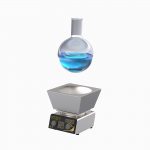Using a Precision Temperature Probe with Your Round-Bottom Hotplate Stirrer
CAT Scientific is your trusted supplier of sturdy, reliable laboratory equipment intended to facilitate stirring, mixing, blending, dispensing and homogenizing tasks. Ranging from high-speed homogenizers to digital magnetic hotplate stirrers, to burettes and overhead stirrers, our products are carefully engineered and manufactured for accuracy, precision, and longevity under real world conditions.
Of course, many suppliers carry magnetic hotplate stirrers, but CAT Scientific gives you the flexibility to choose a digital hotplate stirrer suitable for use with non-standard mixing vessels, such as round-bottom flasks. Our round-bottom hotplate stirrers cradle your delicate round-bottom flasks snugly and securely, so you can focus on your important research, development, and other laboratory investigations and procedures.
To Probe or Not to Probe
 As with our standard flat-bottom digital magnetic hotplate stirrers, our round-bottom capable models (KM 16.4D / KM 16.7D) feature digital controls (and user-friendly manual knobs for adjusting stir speed and setting other parameters), and the ability to use the devices’ hotplate functions — with or without the optional Pt100 temperature probe.
As with our standard flat-bottom digital magnetic hotplate stirrers, our round-bottom capable models (KM 16.4D / KM 16.7D) feature digital controls (and user-friendly manual knobs for adjusting stir speed and setting other parameters), and the ability to use the devices’ hotplate functions — with or without the optional Pt100 temperature probe.
For the most precise control of heating tasks, we recommend plugging in the temperature probe. There’s a DIN connector port on the back of the device for quick, convenient connection. Once inserted in the liquid to be stirred (minimum 5 cm. submersion required), the probe assesses the temperature of the liquid in real time, providing feedback to the hotplate so temperatures can be adjusted and/or maintained as needed. It’s also possible to operate the device without using the probe, but heating may be somewhat less precise.
When using the temperature probe, it’s important to input the volume of the liquid to be stirred. This provides the device’s software the information it needs to accurately predict the thermal capacity of your liquid, so that overheating — or under-heating — can be avoided.
Using the Probe
Connect the probe, then immerse the probe in the liquid. Press the “Power On/Standby” button on the front of the device. If you receive an error message, press the encoder wheel (the dial on the left) to clear the message.
The letter “A” (a prompt for “amount”) should appear in the digital readout. Turn the encoder wheel to select the volume of liquid (in liters) being stirred. Press the wheel/button to enter this amount. Then press the “Probe Temp” button on the control panel. A capital “Pi” symbol (�) should appear and blink. This is your prompt to turn the encoder wheel to select the desired set-point temperature value. Press the wheel/button to lock in your selection. Finally, press the “Plate On/Off” switch, to activate the hotplate.
